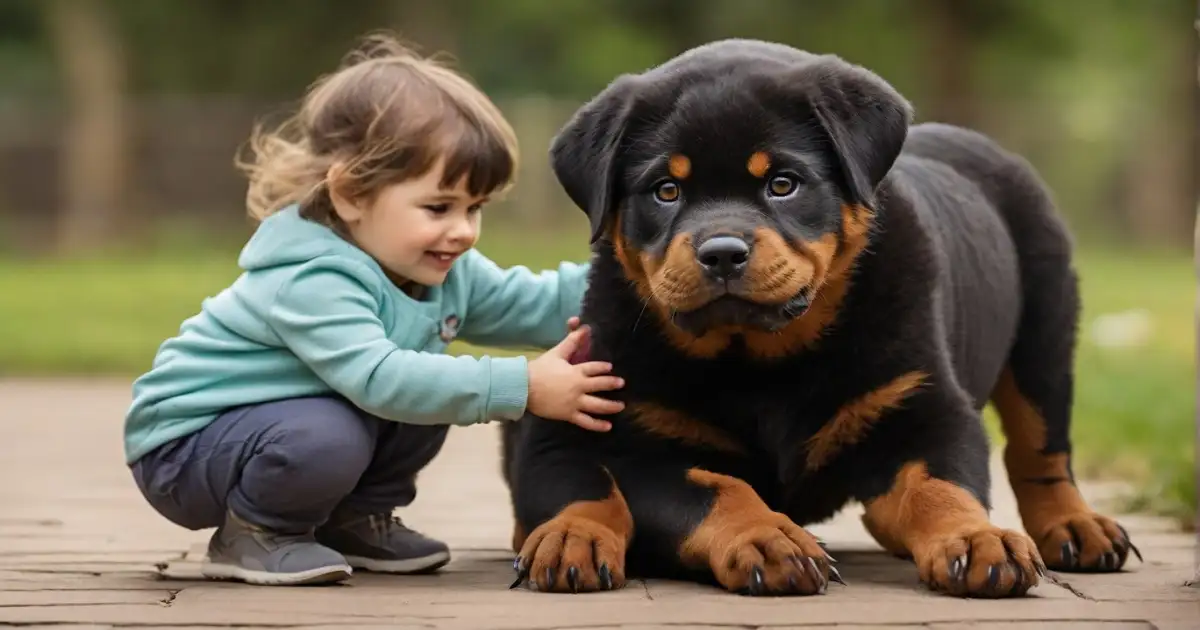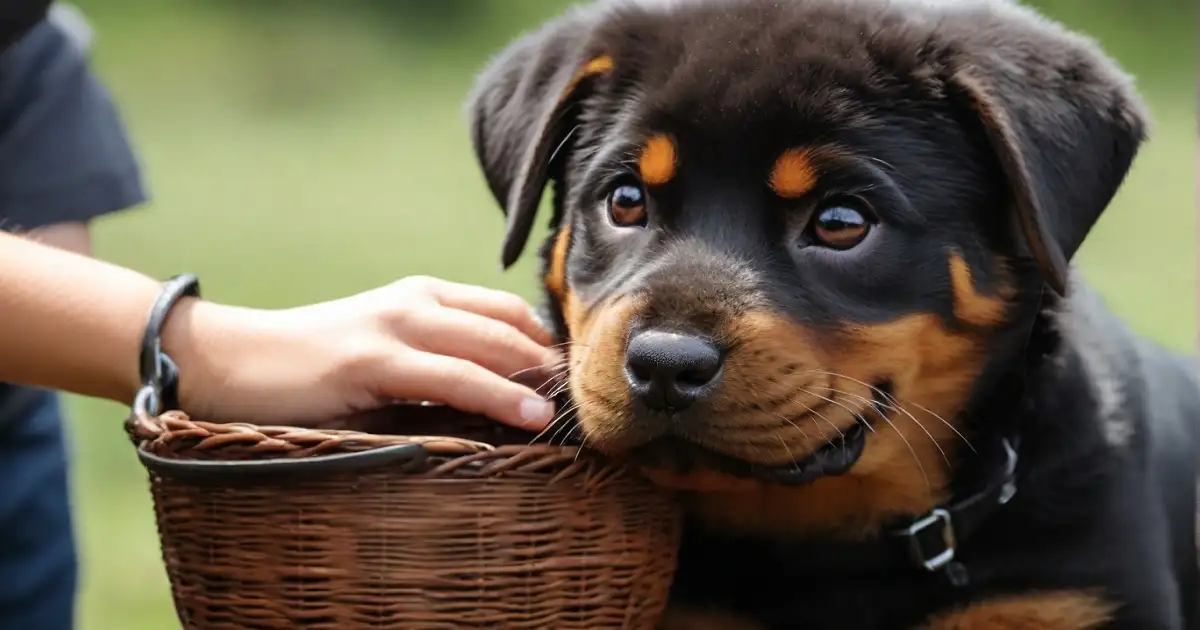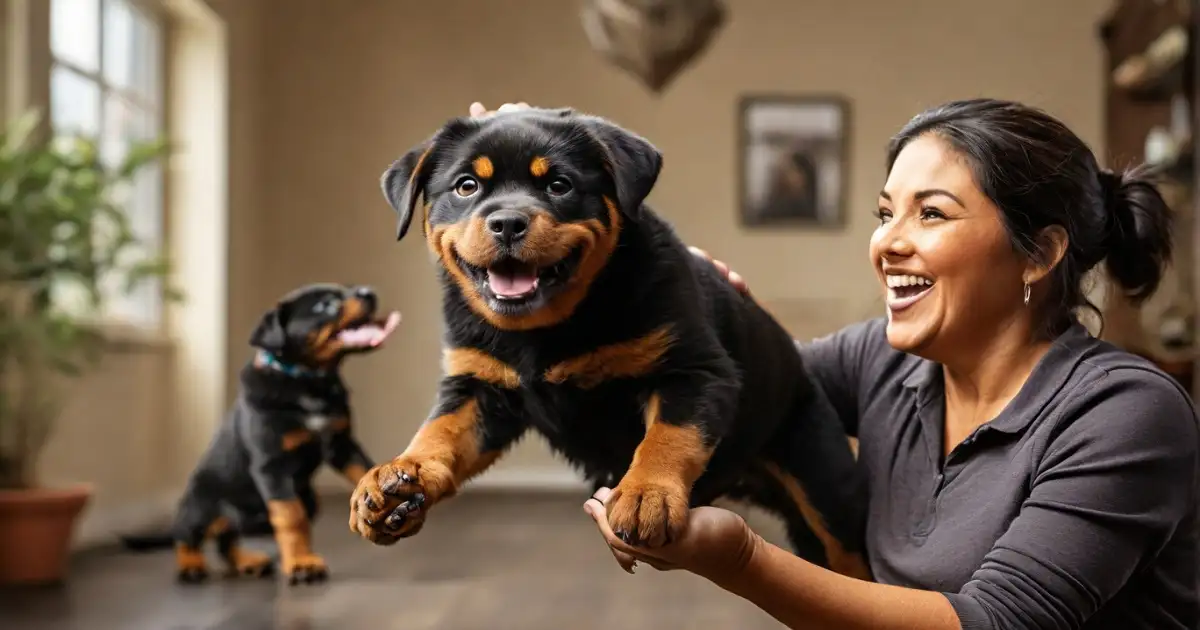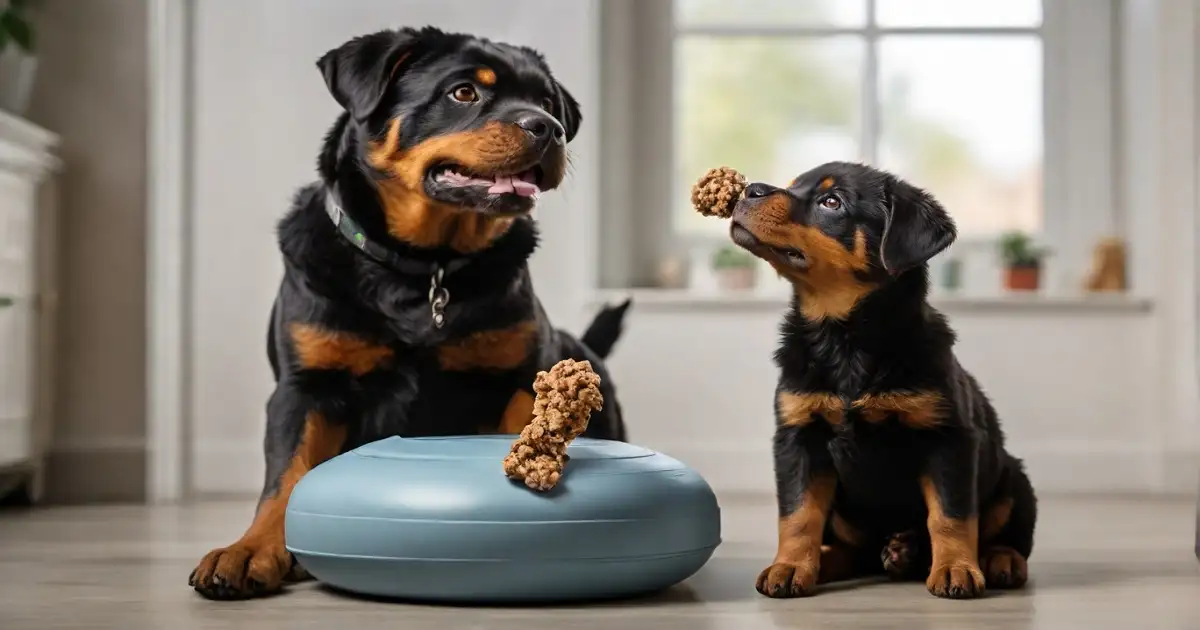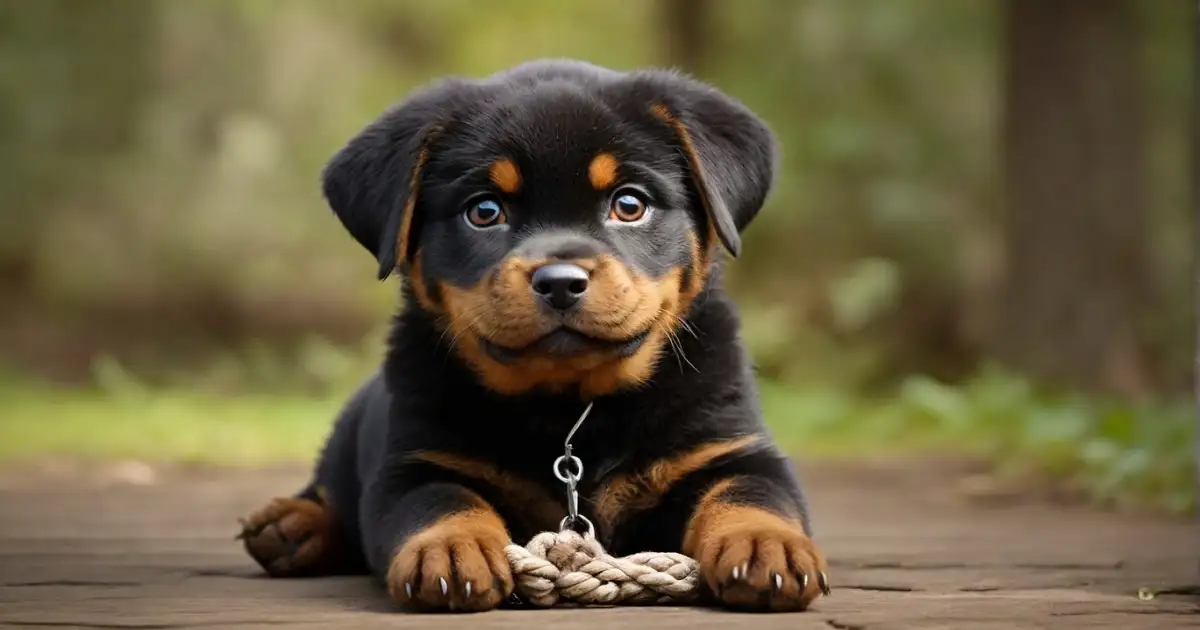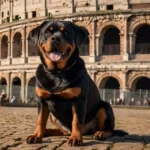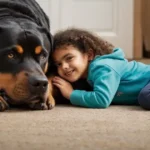Whoa there, looks like someone’s got a Rottweiler pup with a serious case of the nibbles! I understand; dealing with those sharp teeth can be a pain.
But have no fear; with patience and persistence, you can train your feisty furball not to bite. The trick is figuring out who needs to take responsibility – you, the breeder, or a pro trainer?
Well, buckle up, buttercup, because, in this blog post, I’ll discuss how to train a rottweiler puppy not to bite, who needs to step up, and how to curb that gnarly nipping for good.
It takes a village to raise a puppy, so let’s work together to free your little Landshark bite!
Why Rottweiler Puppies Nip and Bite
Rottie puppies aren’t chomping mini-monsters; they’re just being well! Nipping and biting come naturally to them for a few reasons. Firstly, puppies explore the world with their mouths.
Without hands to touch and feel, their mouths are their main sensory organ. Those sharp little milk teeth help them investigate their environment.
Secondly, all that needle-like teething causes pain and discomfort. By chewing and biting, puppies soothe their irritated gums. It’s like when we bite down on an ice cube or popsicle to relieve tooth pain.
Rottweiler puppies also nip and bite when excited or playing. They’ll nibble on hands, clothing, and ankles with glee, especially when riled up. It’s in their nature to wrestle and play rough with litter mates.
So when they bite you, take it as a compliment – they consider you fun and playful like another puppy!
Biting can also be a fear response in some cases. Confused or frightened pups may lash out with their mouths when handled roughly.
Startled or anxious Rotties also tend to nip. So, it’s important to socialize puppies properly and build their confidence.
While biting stems from normal puppy behavior, it becomes problematic when excessive. Those little milk teeth can do serious damage, especially on a large, powerful breed like a Rottweiler.
Letting a mouthy puppy turn into an untrained adult dog is risky. The time for Rottweiler Puppy Not to Bite training is NOW! With effort from all parties, your landshark’s bite can turn nasty to non-existent.
When Puppy Mouthing Becomes Problematic
Excessive nipping and biting is unacceptable, no matter how cute the perpetrator may be. Those sharp little puppy teeth can result in injuries, especially with a strong breed like Rottweilers.
An untrained, biting puppy can quickly become an uncontrollable adult dog with serious behavioral issues. There are also major liability issues if a biting Rottweiler puppy harms someone.
Rottweiler Puppy Not to Bite training is not just about manners; it’s a safety issue. Rotties have extremely strong jaws capable of inflicting significant damage if they bite.
According to dog bite statistics, Rottweilers accounted for the second-highest number of canine attack fatalities.
While certainly loyal companions, Rottweilers also made the American Kennel Club’s list of the top 5 dog breeds most likely to bite humans.
So, proper bite inhibition training is critically important for public safety and your pup’s future behavior. With persistence and patience from all parties, even the mouthiest Rottweiler puppy can be taught not to bite.
The Responsibilities of the Breeder For Rottweiler Puppy Not To Bite
Selecting a responsible and reputable breeder is the critical first step in ensuring a Rottweiler puppy grows into a well-behaved and non-biting adult dog. The breeder plays a pivotal early role in proper socialization and Rottweiler Puppy Not to Bite training.
A responsible Rottweiler breeder will properly socialize the puppies from birth and begin foundational bite inhibition training. It involves handling each puppy frequently and getting them used to human touch and interaction.
The pups should be exposed to various sights, sounds, and stimuli in a positive way to build confidence. The breeder should monitor littermate interactions and correct any rough biting or aggression.
Showing the mother’s example of appropriate discipline is also effective. Puppies learn how to regulate biting pressure through this early feedback. In addition, the breeder should advise new owners on the training needs of Rottweilers as a breed.
They should guide the management of mouthing and nipping so the Rottweiler Puppy Not to Bite training can continue seamlessly. Reputable breeders also make themselves available for questions and support down the road.
Signs to Look for in a Reputable Breeder
When searching for a Rottweiler breeder, look for the following signs of a responsible breeding program:
- Several years of experience breeding Rottweilers, specifically
- Focus on health, temperament and conformation
- Litters are raised in a clean, stimulating environment
- Puppies are handled frequently to support socialization
- Carefully monitors puppy play and interactions
- Gentle yet firm handling of puppies
- Screens buyers to match puppies to the right homes
- Provides support and guidance to new owners
Doing due diligence to select a stellar breeder gives your Rottie puppy the best start on becoming a well-adjusted, non-biting adult dog. Proper early socialization and training is a joint effort between ethical breeders and committed owners.
The Responsibilities of the New Owner
Once you bring home your Rottweiler puppy, most training and socialization duties shift to you as the new owner. While the breeder laid the foundation, you must continue proper Rottweiler Puppy Not to Bite training.
As the new owner, you must establish clear rules, routines and boundaries with your Rottweiler puppy. It provides the structure and guidance young pups need. Housetraining, crate training, scheduled feeding and nap times, and ongoing socialization should be prioritized.
You also must learn to understand normal puppy behavior and make any necessary adjustments. Rambunctious nipping and rough play come naturally to Rottweilers.
While training techniques will curb biting, some mouthing when excited is inevitable. So, learn to read your puppy’s body language and watch for overstimulation.
Providing plenty of stimulating activities is another owner’s obligation. Rottweiler puppies need constant outlets for their energy and intelligence.
Interactive playtime, chew toys, food puzzles, and training sessions are all critical. A tired puppy is less likely to act out with biting and mouthing.
Professional training should begin as soon as possible. Sign up for puppy classes or work privately with an experienced trainer.
They can teach proper disciplinary techniques, redirection methods, and commands tailored to your Rottweiler puppy’s needs.
How Owners Should Respond to Puppy Biting
When your Rottweiler puppy bites, here are some dos and don’ts:
- Remain calm. Do not yell, punish or react aggressively.
- Use a firm “No” or “Stop.” Be consistent with commands.
- Redirect to a chew toy. Reward when they switch to the toy.
- Withdraw attention if biting continues. Give a reverse timeout.
- Praise and treat when the pup stops biting. Positive reinforcement works.
- Do NOT strike, scream, or startle the puppy.
While frustrating, remember biting is communicating, not aggression. With patience and consistency, even a mouthy Rottweiler pup will respond to training.
Getting Professional Help with Bite Training
While owners play a lead role, seeking professional guidance is key for effective Rottweiler Puppy Not to Bite training. The knowledge of an experienced dog trainer or veterinary behaviorist provides immense value. Enrolling your Rottweiler puppy in group training classes provides socialization and education.
Puppy kindergarten teaches basic obedience, bite inhibition, and exposing your pup to new dogs and people. More advanced classes continue reinforcing training.
Private lessons with a qualified trainer are ideal for individualized guidance. They can observe your puppy’s behavior and tailor techniques to curb the biting. For severe biting issues, a board-certified veterinary behaviorist may be needed.
Muzzle training is another useful tool under a trainer’s guidance. A basket-style muzzle allows your puppy to pant, drink and take treats while preventing biting during training. It adds an extra layer of safety when handling nippy Rottweiler puppies.
What to Expect from Professional Training
Here are some of the techniques a skilled dog trainer may employ for Rottweiler Puppy Not to Bite training:
- Redirection – Entice biting onto a toy and reward non-biting behavior
- Reverse timeouts – Stand up and ignore the puppy briefly when they bite
- Positive reinforcement – Treats, praise for not mouthing
- Corrections – Firm verbal cues like “stop’, “no bite.”
- Socialization – Safe exposure to new environments and dogs
- Confidence building – Desensitization to stimuli that evoke biting
A professional trainer will also demonstrate how owners should discipline appropriately without scaring the pup. They will review tips for managing excitement and preventing overstimulation leading to biting. Ongoing support will be provided to troubleshoot any setbacks.
While trainers offer immense value, owners must consistently implement the techniques at home. With professional guidance and committed owners working together, a Rottweiler puppy can overcome biting urges and become a trusted companion.
Consistency is Key in Biting Training
When it comes to Rottweiler Puppy Not to Bite training, consistency truly is king. With consistent reinforcement from owners, even the best professional advice will succeed.
First and foremost, all family members must get on the same page. Everyone must use the same techniques, commands, and responses the trainer recommends. Mixed messaging will only confuse your Rottweiler puppy and delay progress.
In addition to household consistency, training must be reinforced everywhere – not just at home in quiet settings. Practice commands, redirection, and praise in different environments so your pup learns good behavior, which is expected everywhere.
Establishing a consistent schedule of short, positive training sessions is also crucial. Daily practice strengthens the message that mouthing and biting are unacceptable. Keep sessions brief to maintain your puppy’s focus and engagement.
Patience and persistence are vital. Your Rottweiler puppy’s urge to bite may initially worsen during teething around 16-24 weeks of age. Stick with the program and do not give up – regression is normal as pups test boundaries.
Staying motivated and engaged with your puppy during training yields the best results. Keep things lively and upbeat and reward good behavior. It establishes clear communication between owner and dog.
Troubleshooting Setbacks in Training
Despite your best efforts, there may be occasional setbacks in Rottweiler Puppy Not to Bite training:
- If biting resumes, remain calm. Do not overreact or reprimand too harshly.
- Analyze patterns. Does the puppy bite more when over-tired, hungry or excited?
- Consider mixing up techniques if you are still looking for improvement. Get a trainer’s advice.
- Any signs of true aggression warrant an immediate vet check.
- Ensure your Rottweiler pup gets sufficient physical and mental exercise.
The path to biting inhibition has ups and downs. You can get your puppy’s training back on track by staying level-headed, observant and flexible in your approach. Be sure to celebrate small wins along the way, too!
Conclusion
In summary, training a Rottweiler puppy not to bite requires commitment and collaboration from all parties. While nipping and mouthing are innate puppy behaviors, allowing them to continue can have dangerous consequences for large, powerful breeds like Rottweilers.
Responsible breeders lay the groundwork by properly socializing puppies and teaching bite inhibition with littermates early on. It gets the Rottweiler Puppy Not to Bite training started on the right paw during the pivotal early weeks.
However, the primary responsibility lies with the new owner. Continuing socialization, establishing structure, learning canine communication, providing stimulation and seeking professional guidance are key owner obligations.
Owners can shape their Rottweiler puppy’s behavior with persistence and consistency. Even the most dedicated owner needs additional support from veterinary behaviorists, certified trainers and puppy classes.
Their expertise in proper techniques, discipline methods, and troubleshooting makes a difference. They offer an objective perspective on the puppy and help owners achieve training goals.
While not always linear, the path to biting inhibition is very achievable with teamwork. With the breeder, owner and professionals working together, even a bitey
Rottweiler puppies can be taught to greet the world with kisses instead of nips. Patience, motivation, and consistency are key – Rome wasn’t built in a day, and neither are puppy manners.
The payoff for diligent Rottweiler Puppy Not to Bite training is an incredible bond with a loyal companion for years.
Rather than a liability, your well-trained Rottweiler becomes a source of joy and protection for your family. So stick with it – the future of your puppy’s behavior is in your hands!
